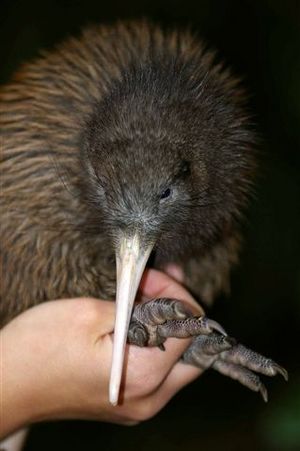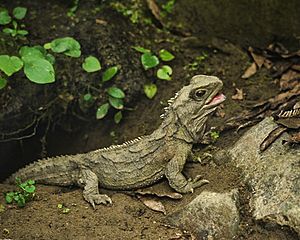Fauna of New Zealand facts for kids

The animals of New Zealand are truly unique! For a very long time, before humans arrived less than 900 years ago, New Zealand was mostly free of mammals. The only mammals found there were those that could swim to the islands, like seals and sea lions, or fly there, like bats. Far offshore, you could also find whales and dolphins.
Interestingly, millions of years ago, during the Miocene epoch, a land mammal called the Saint Bathans mammal lived in New Zealand. This shows that mammals were present when the island first broke away from other landmasses. But over time, they disappeared. Because there were no land mammals, other animals took over their roles. This led to a huge number of unique insects and birds. Many of these birds became flightless, meaning they couldn't fly!

Some famous flightless birds include the kiwi, the weka, the moa (which is now extinct), the takahē, and the kākāpō. Even the bats in New Zealand spend a lot of time on the ground because there are no predators to worry about.
New Zealand is also home to about 60 different kinds of lizards. Half of these are geckos and the other half are skinks. There are also four species of native frogs, but all of them are rare and endangered. Another amazing reptile is the tuatara. It looks like a lizard but belongs to its own very old group of reptiles.
Some butterflies of New Zealand are found only in New Zealand. Many other butterfly species have been brought there by people. Some butterflies, like the Australian painted lady, even fly all the way from Australia to New Zealand during big migrations.
Contents
Why are New Zealand's Animals So Special?
New Zealand's animals are special because the islands were isolated for millions of years. This meant that animals evolved without the presence of many predators. Birds, for example, didn't need to fly away from danger, so many lost the ability to fly. This unique situation created an amazing ecosystem.
How Did Invasive Species Arrive?
Humans first came to New Zealand from the Pacific islands in several groups before 1300 AD. They brought with them animals like the Polynesian rat (called kiore) and domesticated dogs. Later, Europeans arrived and brought many more mammals. These included pigs, ferrets, stoats, mice, rats, cats, sheep, and cattle.
What Impact Did New Animals Have?
Many of these new animals had a very serious impact on New Zealand's native wildlife. Rats, ferrets, cats, stoats, and dogs caused some native species to become extinct. For example, Brushtail possums were brought from Australia for their fur. Deer were brought from Europe for hunting. Both possums and deer have badly damaged the forests where many native birds live.
Protecting New Zealand's Unique Wildlife
In recent years, people have made great efforts to protect New Zealand's native animals. They have successfully removed possums, rats, ferrets, and other mammals from many large and small islands off the coast. The goal is to make these islands more like they were before humans arrived. For example, about 30 tons of dead possums were removed from Kapiti Island.
Similar efforts are happening on the main islands of New Zealand. In some special areas, mammals are being removed from inside predator-proof fences. These fences create safe "ecological islands" where native animals can thrive. Good examples include Zealandia in Wellington city and the Maungatautari Restoration Project. At Zealandia, about a ton of dead possums were removed after the special fence was built.


